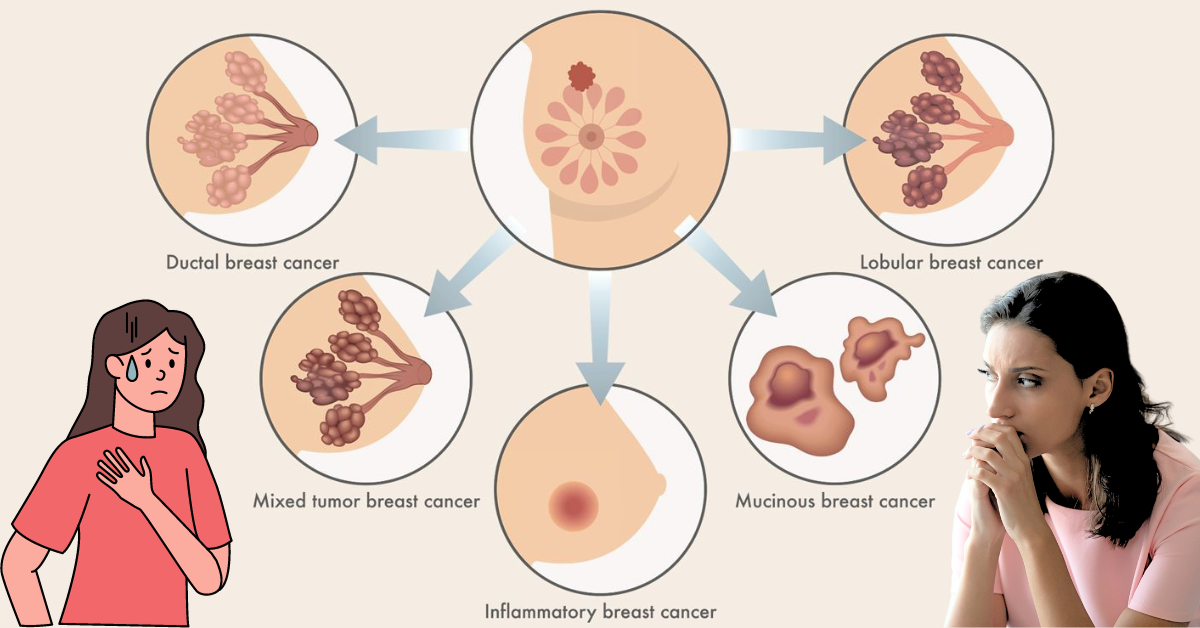Do you know how breast cancer causes death? First, we must see what breast cancer is and how it affects the body.
The three essential components of a breast are connective tissue, ducts, and lobules. The glands that generate milk are called lobules. The tubes that transport milk to the nipple are called ducts. All that surrounds and binds everything together is called connective tissue, which comprises fatty and fibrous tissue.
Cancer of the breast occurs when cells in the breast proliferate uncontrollably. Breast cancer comes in various forms. Which breast cells develop into Cancer determines the type of breast cancer.
Most cases of breast cancer start in the lobules or ducts. Blood and lymph vessels are two ways breast cancer can travel outside the breast. Breast cancer is considered metastasized when it extends to other body parts.
What are the Kinds of Breast Cancer?
These are the most prevalent types of breast cancer:
Cancer of the invasive duct:
The cancer cells start in the ducts and spread to other areas of the breast tissue as they grow. Moreover, invasive cancer cells can metastasize or spread to different bodily regions. This kind of breast cancer is called invasive ductal carcinoma.
Lobular Cancer with invasion:
The cancer cells start in the lobules and subsequently migrate to the surrounding breast tissues. It is also possible for these invasive cancer cells to spread to different body areas. This kind of breast cancer is called invasive lobular carcinoma.
Many additional less common types of breast cancer exist, including inflammatory breast cancer, medullary, mucinous, and Paget’s disease.
A breast illness known as ductal carcinoma in situ (DCIS) can potentially progress to invasive breast cancer. The cancer cells have not spread to other breast tissues; they are limited to the duct lining.
Which Breast Cancer Is Easy to Cure?
| Benign Tumor | Malignant Tumor |
| It’s critical to realize that most breast lumps are benign, not cancerous. | Malignant breast cancer is dangerous, and it is called cancerous cells. |
| Unusual growths and non-cancer breast tumors do not metastasize beyond the breast. | If it is not treated on time, it spreads to the whole body and becomes the reason for death due to Cancer. |
| Certain benign breast lumps can raise a woman’s risk of developing breast cancer, although they are not life-threatening. | Malignant Cancer has life-threatening cells. |
| it may increase your risk of developing the disease in the future. | It is a fatal disease |
A medical practitioner should examine any breast lump or change to determine whether it is benign or malignant (Cancer).
How Breast Cancer Spreads in the Chest?
Dead cells stay in the body and make a poisonous cluster. These cells remain in the body and aren’t filtered out, which becomes the reason for Cancer. When cancer cells enter the blood or lymphatic system and travel to different areas of the body, breast cancer has the potential to spread.
A component of the immune system in your body is the lymphatic (or lymph) system. It is a system of organs, ducts, and lymph nodes—small, bean-sized glands—that cooperate to gather and transport clear lymph fluid from the body’s tissues to the blood. Tissue waste products and immune system cells are in the clear lymph fluid, filling the lymph channels.
The lymph fluid is removed from the breast via the lymph vessels. When it comes to breast cancer, cancer cells can get into those lymph veins and begin to spread to lymph nodes.
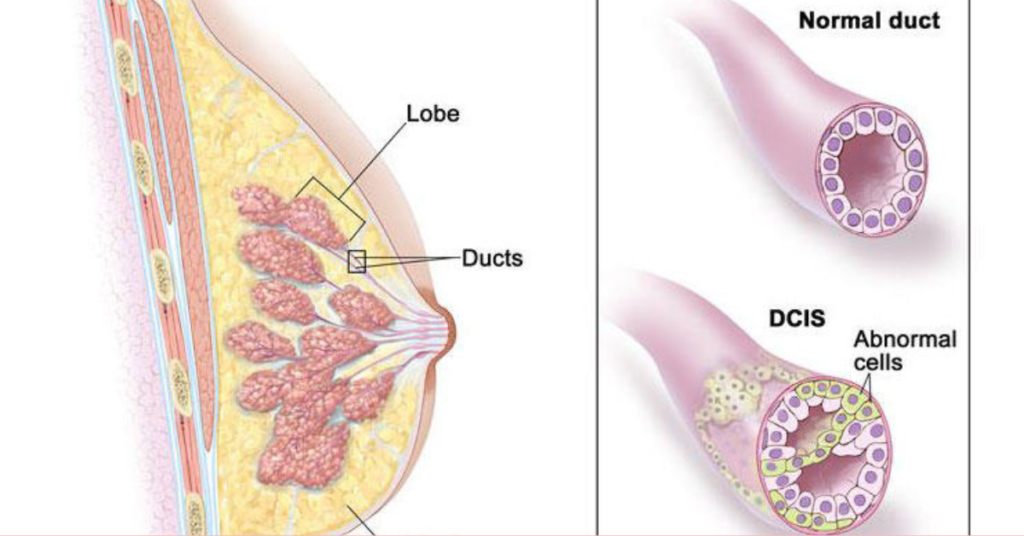
The majority of the breast’s lymph arteries empty into:
- lymph nodes (axillary lymph nodes) beneath the arm
- lymph nodes (internal mammary lymph nodes) located in the chest, next to the breastbone
- Around the collar bone lymph nodes (infraclavicular lymph nodes, which are below the collar bone, and supraclavicular lymph nodes, which are above the collar bone)
There is an increased likelihood that cancer cells may have metastasized or spread to other areas of your body through the lymphatic system if they have reached your lymph nodes. However, not all women with cancer cells in their lymph nodes experience metastases; others may get metastases later, even though they do not have cancer cells in their lymph nodes.
Factors of Why is Left Breast Cancer More Common?
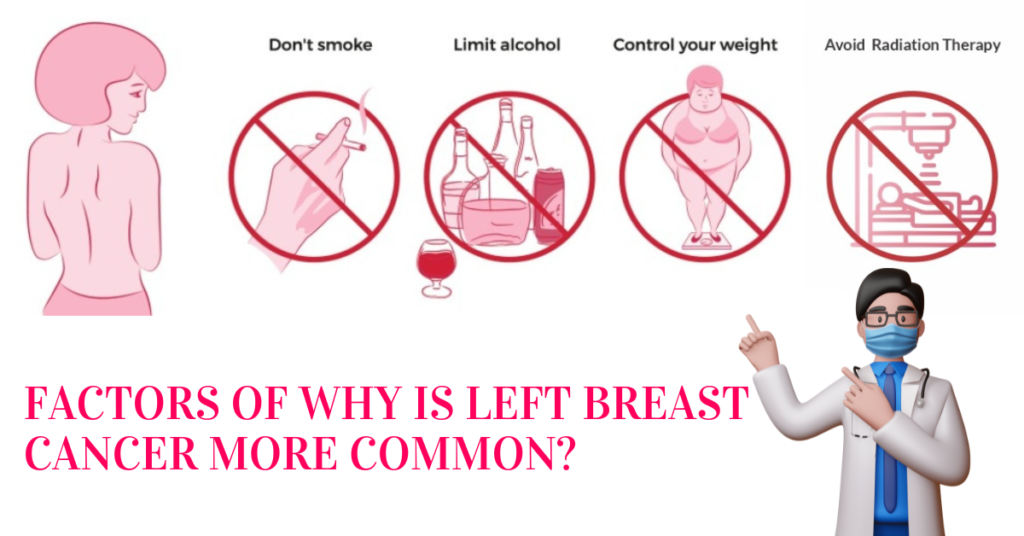
Sexual orientation:
The primary risk factor for breast cancer is simply being a woman. Despite having many more breast cells than males, women are more likely to acquire breast cancer because estrogen and progesterone, two female hormones that stimulate cell growth, are continually present in their breast cells. Although breast cancer can strike men, women are around 100 times more likely to have the disease than men.
Age Factor:
As you become older, your chance of having breast cancer rises. For every three cases of invasive breast cancer, two occur in women 55 years of age or older.
Background in the family. If a close family, male or female, has breast cancer, your chances of getting breast cancer go up. A family member with breast cancer affects 20 to 30 percent of women who develop the illness.
Gene Alterations:
Inherited gene alterations can occasionally result in breast cancer. The most prevalent ones are in the BRCA1 and BRCA2 genes, which result in a markedly elevated risk of ovarian and breast Cancer.
Antecedent Breast Cancer:
Three to four times as many women with Cancer in one breast may likely acquire another cancer in the other or a different region of the same breast. This isn’t the same as the initial Cancer coming back.
Benign Breast Resection:
When breast changes are biopsied or analyzed, about 80% of the cases are found to be benign or not malignant. However, there is a connection between a higher risk of breast cancer and several of these benign breast disorders.
Radiation Hazard:
The risk of breast cancer can rise in individuals between the ages of 10 and 30 who get radiation therapy to the chest. Given during adolescence, when the breasts are still developing, the chance of getting breast cancer seems to be highest.
Exposure to hormones. Hormone replacement therapy, which involves using hormones after menopause, may raise the risk of breast cancer.
How can we Reduce the Risk of Breast Cancer?
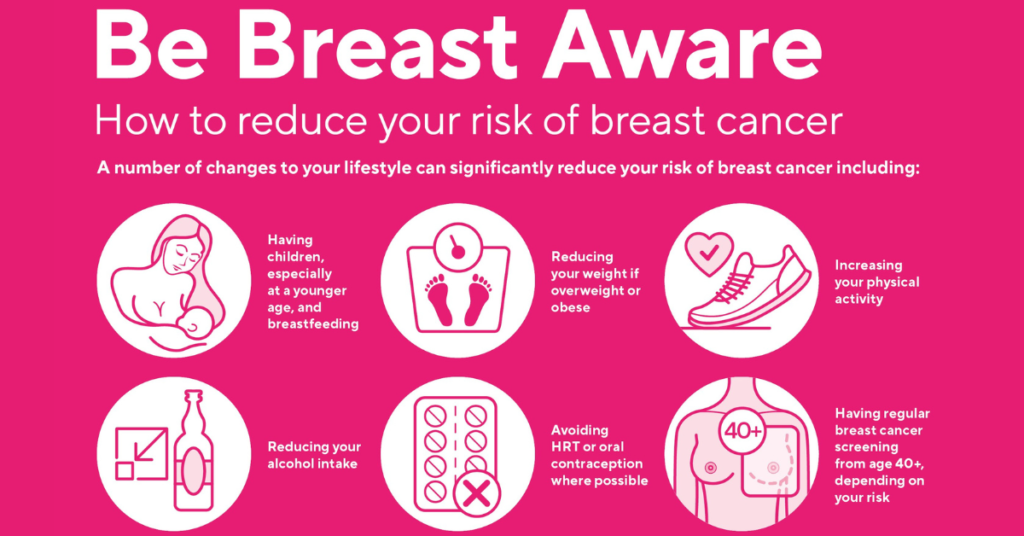
Regular Exercise Regimen:
There is mounting evidence that exercise, namely physical activity, lowers the risk of breast cancer. All that needs to be asked is how much activity you require. In a Women’s Health Initiative (WHI) research, brisk walking for as little as 1.25 to 2.5 hours per week lowered a woman’s risk by 18%. Walking for ten hours a week further decreased the danger.
First Birth Age:
Breast cancer risk is decreased by having several pregnancies and getting pregnant early in life. This effect may be because pregnancy lowers a woman’s overall number of menstrual cycles during her lifetime.
Maintaining a Healthy Weight:
Diets high in fat can cause overweight or obesity, which increases the risk of breast cancer. It has also been demonstrated that a diet heavy in fat affects the chance of getting several other types of Cancer.
Cut Back on Booze:
To lower their risk of breast cancer, women should limit their alcohol intake to no more than one drink per day, according to the American Cancer Society.
Can breastfeeding increase the risk of breast cancer?
According to particular research, breastfeeding may somewhat reduce the incidence of breast cancer. This is more likely to occur if breastfeeding is maintained for 1.5 to 2 years or if the mother breastfeeds multiple children.
How did I know that I had Inflammatory Breast Cancer?
Inflammatory lymph nodes are very dangerous. People feel that something is changing in our skin. It may be a skin reaction, and go to the skin specialist. Most doctors also think it’s a skin problem, but later on, they prescribe that these are breast cancer symptoms. Proliferative Breast Cancer Commonly Misdiagnosed as a Skin Infection.
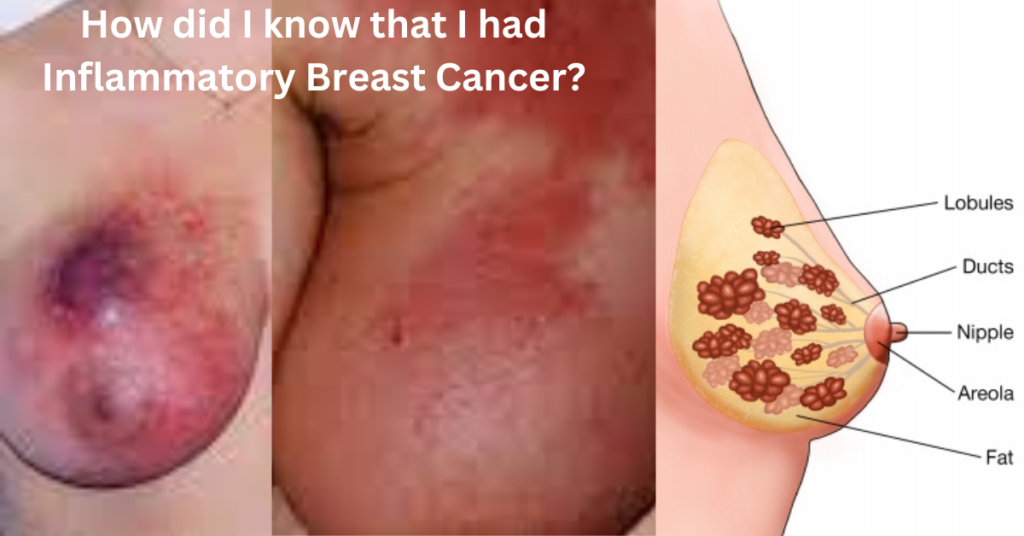
According to the National Cancer Institute, 1 to 5% of all breast cancers are inflammatory in nature. They are frequently confused with skin infections like cellulitis or breast infections like mastitis. Though inflammatory breast cancer is also linked to skin thickening and a pitted appearance that resembles an orange peel, the symptoms—skin redness, swelling, and pain—can be comparable.
How Can Breast Cancer Affect Your Period?
Can breast cancer be the main reason for stopping the menstrual cycle? It’s a prevalent question in our surroundings. Research indicates a connection between a person’s menstruation onset and cessation age. The risk of breast cancer, even though breast cancer doesn’t seem to alter the time or flow of your menstrual cycle. But yes, Some breast cancer treatments may cause your period cycle to halt entirely or to briefly pause.
Why do People Celebrate Breast Cancer Day Every Year?
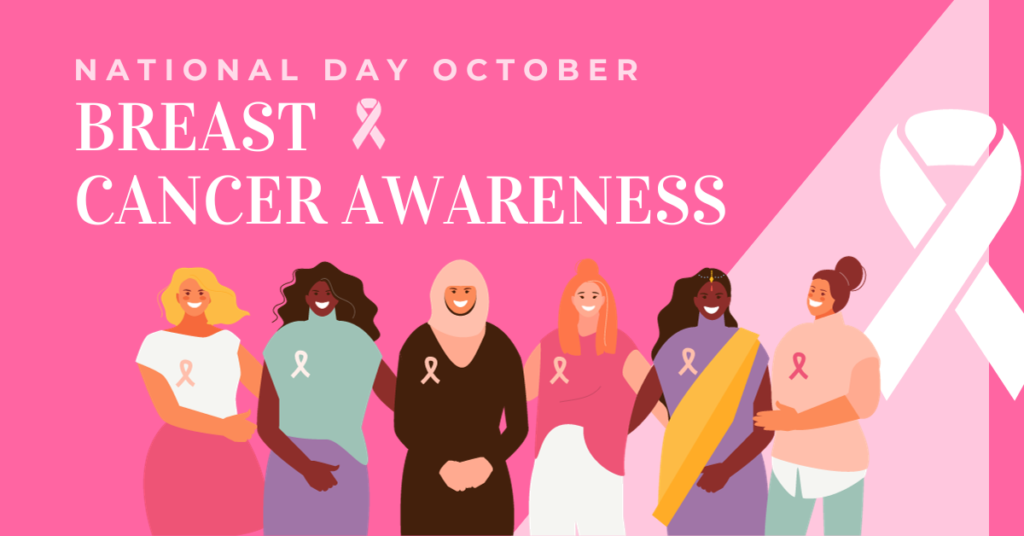
National Breast Cancer is celebrated in October every year. Breast Cancer spreads very fast, especially in women, so it is essential to be aware of this fatal disease so that people take great care of its precautions. In October of 1985, National Breast Cancer Awareness Month was established. This marked the beginning of the United States’ first formal campaign to raise awareness of the risks associated with breast cancer. Public awareness initiatives about this illness have flourished and multiplied ever since.
Which is the Symbol of Breast Cancer?
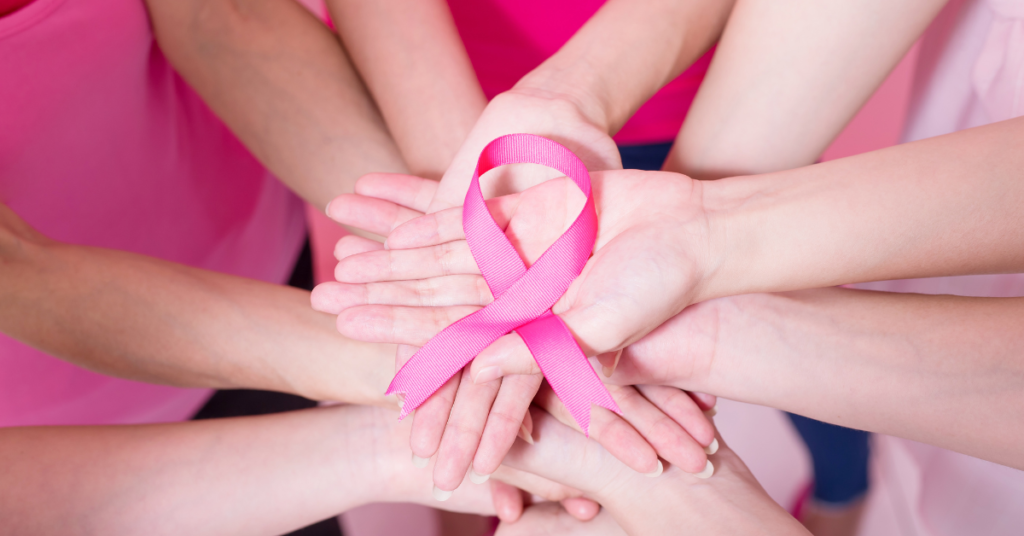
The pink Ribbon Butterfly shape is the symbol of breast cancer. People wear it on Breast Cancer National Day. It’s a symbol of peace for those suffering from Breast Cancer. The Pink Ribbon is shown Below.

